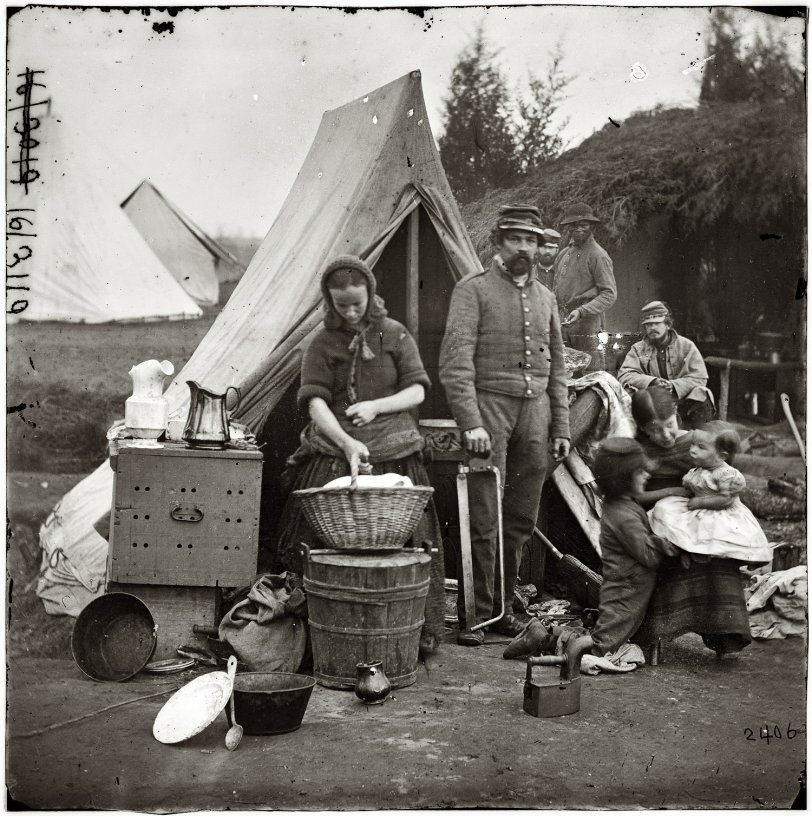


Framed or unframed, desk size to sofa size, printed by us in Arizona and Alabama since 2007. Explore now.
Shorpy is funded by you. Patreon contributors get an ad-free experience.
Learn more.

- Texas Flyer wanted
- Just a Year Too Soon
- WWII -- Replacing men with women at the railroad crossing.
- Yes, Icing
- You kids drive me nuts!
- NOT An Easy Job
- I wonder
- Just add window boxes
- Icing Platform?
- Indiana Harbor Belt abides
- Freezing haze
- Corrections (for those who care)
- C&NW at Nelson
- Fallen Flags
- A dangerous job made worse
- Water Stop
- Passenger trains have right of way over freights?
- Coal
- Never ceases to amaze me.
- Still chuggin' (in model form)
- Great shot
- Westerly Breeze
- For the men, a trapeze
- Tickled
- Sense of loneliness ...
- 2 cents
- Charm City
- What an Outrage
- Brighton Park
- Catenary Supports
Print Emporium
Tent Life: 1861

1861. "Washington, District of Columbia. Tent life of the 31st (later, 82nd) Pennsylvania Infantry at Queen's Farm, vicinity of Fort Slocum." View full size. Wet-plate glass negative, left half of stereo pair, photographer unknown.
Teeming With Women
LOC annotation for these photos: Princess Agnes Salm-Salm, wife of Prince Felix of Prussia, who served with the Union Army, observed in January 1862 that the winter camp of the Army of the Potomac was "teeming with women." Some wives insisted on staying with their husbands, which may have been the case with this woman, judging by her housewifely pose alongside a soldier, three young children, and a puppy [this photo]. In addition to taking care of her own family, she may have worked as a camp laundress or nurse. Some women who lacked the marital voucher of respectability were presumed to be prostitutes and were periodically ordered out of camp. Only gradually during the four years of the war, and in the face of unspeakable suffering, were women grudgingly accepted by military officials and the general public in the new public role of nurse.
Surgical Saw
Surgical saws can indeed be that large.
Butcher saw
It is indeed a bone saw, we found a practically identical one from my grandparents' house after they passed away.
I was informed that it was used to cut bones when butchering beef, pigs and game, as my family had no doctors in it.
So this gentleman may have been a camp sawbones, or butcher or maybe simply repurposed a saw he found.
The chest with holes
Anyone know what the chest with the holes in it (on the left side of picture) was for? I immediately think of it holding living thing, or maybe bread, but perhaps it's simply for ventilation, so the interior won't get too hot or musty. Anyone know?
[Perhaps a trunk or footlocker for clothes and such. - Dave]
Just an old country doctor
I'm surprised no one commented yet on that huge saw. It's obviously not a wood cutting implement. Those kind of blades had much bigger teeth to bite into the wood in that day. A precision hacksaw like that was used for amputations, the kind that gave rise to the doctor's nickname "Sawbones," later famously shortened to "Bones".
A Lovely Pitcher
Amongst all the grittiness, you'll find on the left a beautiful white ceramic pitcher. How long was the exposure time for making photos in this era? You'd expect the children, especially, to be blurry due to their constant movement, but they are almost crystal clear and frozen with expression. Fabulous photo.
[Outdoors, a few seconds. - Dave]
Families?
How common was it for soldiers to have their whole families with them? Better yet, WHY were the families with them? Here I was, thinking I knew so much until Shorpy comes along and turns everything I thought I knew on it's head. Thanks!
Steam Iron??
Is that an iron on the ground (middle, front of picture)? If so, what is the spout for except, perhaps, water? Anybody know?
[The vent in a charcoal iron is for air, not water. A bellows would be attached and pumped every few minutes to keep the coals inside hot. - Dave]
Queen's Chapel Road
Great photo. I still can't envision working farmland within the District.
Richard Queen's family operated a 1,000-acre farm that stretched from Rock Creek Church to what is now the Langdon neighborhood in Northeast. Queen's Chapel Road is named after his estate chapel, which serviced the growing Catholic community in Prince George's County and, after 1792, the District of Columbia.
























On Shorpy:
Today’s Top 5